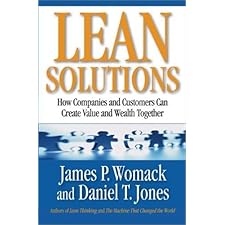Technology Transformations
|
|
Lean Solutions: How Companies
and Customers Can Create Value and Wealth Together

by James P. Womack and Daniel T.
Jones,
The
Lean Enterprise Institute, Inc.
"an education, publishing, and research organization with an action plan. Compared with traditional "think" tanks, we are a "do" tank."
See http://www.lean.org.
Clever ideas about applying lean, JIT manufacturing successes all along the
value chain in the customer service, provisioning and delivery side, not
just backwards down the supply chain. Womack and Jones take us through typical consumer service and buying experiences and do a rough calculation of the cost of waste in the system from the customer's hold time when making an appointment to the cost of service technicians waiting for parts while a half-completed item fills the available workspace. They also look at the cost to consumers, retailers and producers of stock-outs on popular items while shelves overflow with the deeply-discounted leftovers that obviously no sane consumer wants, but ends up settling for.
Lean principals: give the
end-user/customer what he needs, when he
needs it, where he needs it in a
complete solution and ruthlessly remove steps from your process
that don't support that. Lean processes add a necessary level of
complexity to business analysis, as they insist in measuring the true
cost of processes, goods and services end-to-end and cradle-to-grave,
including processes outside the business unit. Information systems
have the horse power and the data available to do this, but often only
apply an analysis to a tiny silo within the overall
supply/provisioning/consumption chain. True BI solutions will need to be
much more sophisticated and much more collaborative from raw material
supplier to consumer to recycler in order to provide optimized solutions
that actually reduce total cost of ownership. Meanwhile, lean
thinking can result in vast improvements in any process chain as all
participants concentrate on replacing steps that add little or no value
with actual solutions that users will be happy to pay for.
|
|
Copyright © 2013 Third Coast Complexity
Consultants | Last modified:
09/09/2013
| |